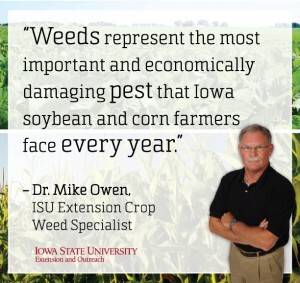Last week I had the opportunity to attend the 25th Annual Integrated Crop Management Conference on campus at Iowa State University in Ames. This conference provides the latest information on crop production technology, and I always look forward to hearing research findings that can help farmers increase yields.
It comes as no surprise that the first session of the first day would be a Weed Management Update from Dr. Mike Owen. What was a surprise is just how severe the growing weed resistance problem has become! A survey completed this fall shows that 70% of all soybean fields in Iowa had weeds showing above the canopy at harvest.
Although the most current emphasis has been on glyphosate-resistant weeds, it’s important to understand that all herbicides used on a stand-alone basis will eventually fail. The best management practice for achieving weed control is still a diversity of tactics: cultural, mechanical and herbicide.
 Soybean growers should choose programs that will use products from as many herbicide groups, or families, as possible. There are no new herbicide mechanisms of action for the coming year, but there will be some new mixtures and new formulations using older class chemistries as base components. Rotating between various herbicide traits is important from the standpoint of reducing weed resistance is also key to achieving higher soybean yields.
Soybean growers should choose programs that will use products from as many herbicide groups, or families, as possible. There are no new herbicide mechanisms of action for the coming year, but there will be some new mixtures and new formulations using older class chemistries as base components. Rotating between various herbicide traits is important from the standpoint of reducing weed resistance is also key to achieving higher soybean yields.
Correct management of weeds will make you more money every year than managing any other pest complex, writes Dr. Owen in a blog post. Herbicide-resistant weed populations are increasing at an increasing rate in Iowa; these weed shifts are the result of the management decisions you make. No single tactic will protect the potential crop yield nor deter the evolution of herbicide-resistant weed populations. Be proactive and make plans to manage herbicide resistance in 2014.
